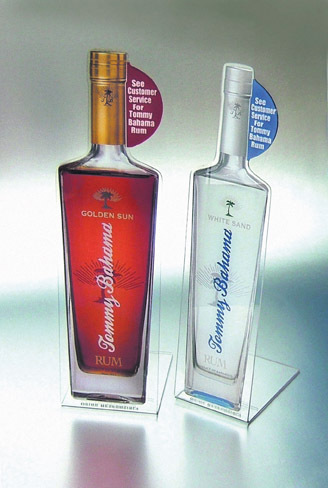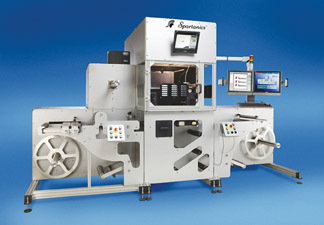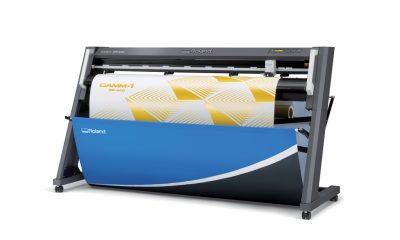Graphics Printing
Published
16 years agoon

An expanding range of media, new printing-equipment options, and increasing customer expectations for fast turnaround and high print quality make point-of-purchase a challenging market to serve. To find how print providers are adapting to the changes in P-O-P, Screen Printing magazine recently spoke to the leaders of five highvolume printing companies that are heavily involved in this market. Here’s what they had to say:
An expanding range of media, new printing-equipment options, and increasing customer expectations for fast turnaround and high print quality make point-of-purchase a challenging market to serve. To find how print providers are adapting to the changes in P-O-P, Screen Printing magazine recently spoke to the leaders of five highvolume printing companies that are heavily involved in this market. Here’s what they had to say:
SP: What are some of the most significant changes you’ve seen in the P-O-P industry during the past five years?
Puryear:
We have seen a significant amount of permanent P-O-P display manufacturing moving to China, along with huge amounts of textile printing. Our industry is faced with the same challenges as other manufacturing concerns in the US. You have to expect these things to continue and specialize in areas that foreign competition can’t easily overcome, namely time and distance.
The continuing explosion in computer technology such as electronic file transmission, FTP sites, and remote proofing systems has shortened production timelines tremendously. I believe this technology has made customers expect us to produce as fast as they can transfer files over the Internet. We have streamlined our operations and invested in faster production methods to address this trend, but I don’t think we will ever be able to print at the speed of light.
Alexander:
We’ve seen recently that P-O-P has become permanent and semi-permanent graphics, not just the 50- to 60-day wonder material that gets put up and then taken down. The other significant change is digital printing technology, as well as the need for speed and other services beyond printing graphics, particularly fulfillment.
Blee:
Turnaround times are a major change in the last five years. In the past, we would do maybe one large project a month with a 48-hour deadline. Today, we do that two to three times a week. The second change is the buyers not being able to keep up with all the information on all the digital devices in the marketplace. It makes it hard to have them understand what an HP TJ8500 does, let alone how it can lower their costs. We are in the industry, and it is hard to keep up with the Joneses next door when it comes to buying equipment.
Kissel:
Technology has drastically changed in the last several years. We are seeing more people entering the marketplace with the new digital technology. We have also seen a dramatic change with the lead times in relation to promotions and projects.
Jacobs:
Control, consistency, color saturation, and line resolution in screen printing large, four-color-process graphics. Also, the growth of digital and its corresponding achievements, such as the resolution it achieves, ink adhesion to a variety of substrates, and the speeds in which the technology can produce graphic images.
SP: Which P-O-P applications do you see growing or declining in popularity? What are the buying patterns of your customers?
Puryear:
Large exterior banners in high quantities seem to continue to slide away. Sign ordinances and zoning restrictions have curbed the use of these products. Large interior banners and other big P-O-P pieces are still popular. As the big-box retailers increase their number of outlets, demand for large interior graphics follows that growth pattern. We have seen an increase in demand for high-quality, four-color-process production and 3-D displays that are thermoformed, heat bent, diecut, or routed to shape. Your ability to produce high-quality screen or digital printing will help you win market share in an industry where overall demand is not growing, according to industry experts.
Alexander:
What we see is direct to substrate. Lifestyle graphics seem to be becoming more and more prevalent, which include pictures of people, places, and things, and emphasis on a more healthy environment. We’re seeing a lot of localized or customized applications and graphics. The buying patterns of our customers are shorter runs, more targeted to either a region of the country or a group of people of a nationality, ethnic background, etc.
Blee:
Growing is green-friendly products. Anything that has even the smallest positive effect on the environment is what customers are looking for. Declining are the real expensive cool things, such as lenticulars, holograms, specialty glow-inthe- dark or glitter inks, or any materials that have a unique feature to them. If it is exotic, most people don’t want to pay for it. Yet they always want something better and newer than what the other guy has.
Kissel:
We are seeing applications growing with in-store promotional materials, whether it is static clings, floor graphics, wobblers, header signs, or end caps. However, we are seeing somewhat of a decrease with banners in a promotion due to the city or state ordinances. In dealing with retail chains, fast food, and supermarkets, they are all trying to drive traffic with the in-store promotions.
Jacobs:
Marketing trends over the past five years have certainly suggested flat to no growth in screen printing as well as offset lithography. For this reason, many companies have diversified their capabilities by offering digital and photographic as visual graphic alternatives. In addition, many larger companies are also complementing their offering to include fulfillment, distribution, and implementation. Customers today want you to manage as much of their business as possible. The one-stop shop, so to speak, has become a preference. They can then deal with one company, one contact, thereby minimizing the stress and the paperwork. Today, many clients do not appear to be concerned with how the graphics are produced, whether screen printed, litho, or digital. They just want it done seamlessly.
SP: How have recent technological trends affected P-O-P production in your business?
Alexander:
We certainly are seeing more customization of graphics. We are seeing prices come down just for the printed work itself. There is more competition. The price per square foot over the last 18 months is coming down.
Blee:
We feel that what we call the only companies will struggle in the future. If you are only a screen printer or only an offset company, the future may get tougher. Customers will need more production solutions from a single vendor. We believe in a vertical model called Concept to Completion. We offer full-service design, print, post-print production, and shipping and fulfillment. Technology allows us to be more competitive at every step of the way.
Kissel:
Digital technology has affected our P-O-P production. Going digital vs. screen eliminates a lot of past steps, which in turn allows us to produce the product faster, more economically, and with better consistency.
Jacobs:
The new technology often times creates the necessity to aggressively look for ways to become more efficient; streamline the operations through lean thinking so you can maintain a competitive edge without eroding the margins.
SP: How has the relative importance of screen printing versus digital printing for P-O-P work in your business changed over the past five years? What percentage of your P-O-P work today is printed digitally?
Puryear:
I see screen printing and digital printing as complementary rather than competitive with one another. We no longer think of ourselves as screen printers. We think of ourselves as manufacturers of signs and displays for our customers. The end user cares little about the method of production used, as long as the final product meets their requirements for quality, price, and delivery.
Currently, our production mix is 86% screen printing, 10% digital, and the remaining 4% is brokered to litho, flexo, and Indigo printers. We found that adding digital printing technology increased demand for our screen printing as we became able to supply a greater share of our customers needs overall. As printing technology evolves, we will evolve along with it to best serve our customers’ needs.
Alexander:
We are seeing less need for screen, more for digital. Again, I think the bigger runs are becoming less frequent, even on national roll-outs, where they are customizing for a region of the country or particular area. It is lending itself to getting more into digital printing. The speed in which people need it faster to market is driving digital printing more than screen printing. A total of 65% of our work is digitally printed versus screen printing.
Blee:
Less than 25% of our work is printed digitally versus by screen printing.
Kissel:
Over the last five years with the technology of digital, the digital equipment is becoming much faster, allowing us to skip past processes and produce faster. Today, we carry all three mediums of print: screen, litho, and digital. With our digital capabilities today, we utilize this process about 20%.
Jacobs:
The changing technologies have not made one process more important than the next. In fact, the digital revolution has motivated us to perfect the screen process. We print a finer line with greater color and contrast today than ever before. For Coyle, screen printing remains our core competency; however, digital technology has been embraced as well to address the changing requirements of the market. Presently, screen printing represents 90% of our volume.
SP: What types of P-O-P jobs are more likely to be digitally printed than screen printed?
Puryear:
Short-run, four-color-process jobs are more economical on a digital press. We also employ digital printing for higher value substrates where you can’t afford to waste stock getting up to color. We also prefer digital printing for very small pieces in full color that would be difficult to register on our best screen press.
Alexander:
Digital printing—shorter runs, ones that are required next day or within a day or two. And the ones that we are starting to see a lot more are ones that require higher resolution. Jobs that are screen printed are ones that have a specific line color or brand color that digital printing may not hit 100%. Obviously, the longer runs or bigger plan roll-outs.
Blee:
Cost and time are the driving factors for scheduling. Since we manage color equally the same for digital and screen devices, we are able to move projects in and out of them on a regular basis for optimal effects.
Kissel:
P-O-P projects printed digitally are ones that are shorter runs, with quicker lead times, and are quality-critical jobs. There tends to be more consistency in digital, due to many variables that have been eliminated with the screen-printing process.
Jacobs:
Typically, production run length will determine how the job needs to be produced, unless the client has a specific request for one over the other.
SP: Which P-O-P materials are creating the most opportunities for your business and why?
Alexander:
We see it in two areas. One is expanded PVCs. Now that you can print direct to substrate, we are seeing more and more of that. And the other one is window film, both translucent film that can effectively make a window sign, and we are seeing more and more of the see-through window graphics.
Kissel:
The P-O-P materials that are creating more opportunities for our business are the larger amount of retail signage we are producing. Retailers are trying to drive more traffic to their locations.
Jacobs:
While screen printing successfully prints on a huge variety of indoor and outdoor materials, no one product, in the last several years, has offered us any unusual opportunities.
SP: How has competition in the P-O-P market affected the way you do business?
Puryear:
You can only fight so many battles at once, so we took a different route. We elected to be different from our competitors by vertically integrating with a display-manufacturing company that had no printing capabilities. We merged, moved out of our respective factories, and consolidated under one roof. Now we have everything it takes to design, print, diecut, thermoform, assemble, and install electronics, if needed. We make the complete display in-house and handle fulfillment as well. The printed substrate comes right out of the press room and goes directly to manufacturing. We have complete control over quality and are not dependent on outside vendors to make our deadlines. The efficiencies of this type of operation allow us to go to market at a very competitive price while maintaining a sufficient profit to sustain growth and reinvest in technology.
Alexander:
Lower prices, faster turnaround times, a lot of pressure to add other value-added processes—particularly fulfillment—and continue to invest in digital technology.
Blee:
As far as our competition, we have a lot of respect for the people we compete with. They make us work hard every day to make ourselves better.
Jacobs:
Good, healthy competition forces you to improve all of your processes, internal and external. Continuous improvement, lean manufacturing, and embracing change and diversification are the thought processes that we have adopted that keep us in a position to support our clients.
SP: Has the profitability of your P-O-P business changed? If so, what corresponding changes have your made or do you intend to make in production or marketing?
Puryear:
Your question implies that our profitability must have gone down somehow. It certainly would have if we had not redefined ourselves as complete manufacturers of displays and made our business model more efficient by design. Through intense training of our staff by leading experts, specifically Nazdar Consulting Services, we were able to achieve higher profits through internal quality control. The key is education, training, and internal efficiency in printing and manufacturing.
Alexander:
Yes, it has. As I mentioned, margins are coming down because the price per square foot for just the printed graphics is, in fact, coming down. What we are trying to do to combat that is look for the value-added services that we can provide. We are looking at partnering with other types of print media, so that we can give our customers a one-stop shop. We’re expanding our capabilities more and more in the fulfillment area. On the internal side, to help offset the lower prices, we are trying to get better operationally. It’s an overused word, but we continue to look at lean operation and continuous improvement in processes.
Blee:
Margins are a lot tighter than they were five years ago. Gas, food, and power all can go up in price, yet customers want us to lower our prices as every year goes by. As far as corresponding changes we have made, we watch the expenses on a daily basis.
Kissel:
I do believe the profitability has changed and will continue to change as the technology continues to be enhanced. Currently we have two VUTEk presses, an HP Scitex Turbo Jet 8500, Inca Turbo, and a Zünd printer. We have three inline presses that vary from 80 to 120 in. and multiple one-color presses.
Jacobs:
When differentiation in your business becomes less clear, margins and profits can ultimately suffer. While it is true that these new technologies cause a higher level of competition for a certain percentage of the business, it can also be said that these changes provide more opportunities to conduct business with new clients as well as an increased amount of business from your existing client base. As I stated earlier, from a production perspective, we have become a better, smarter, and more efficient producer of P-O-P due to these changes in technology.
SP: Are you seeing an increase in shorter run lengths or large campaigns that entail graphics customized for specific regions or customer locations?
Puryear:
Oh yes, large marketing campaigns that are locally customized by price, retailer location, etc. have been increasing for the past several years. This is a good thing for screen and digital printing. Sometimes we use both printing methods on the same sign. You can screen print a common graphic in large quantities and customize it later with digital imprinting. It’s a beautiful marriage of two complementary types of print production. You can’t tell the difference between our screen and digital production unless you look very close.
Alexander:
Very much so. We’re seeing both. With some of our larger accounts, when they do national programs, we’re seeing at least a regional program, but we’re seeing campaigns directed at a certain nationality or ethnic background. We’re seeing that even in some of the large holiday programs, where they focus on a region of the country, it’s hard to have a snowy scene when you are shipping product to the deep south.
Blee:
We feel that regional and variable P-O-P printing will be a major requirement for our business. While not here yet, we are already underway to meet this new market challenge.
Kissel:
There has been an increase in shorter run lengths, with customization of price points or offerings by different regions that are currently done through the digital process. Previously, it didn’t make good economic sense, but today with the digital process, it makes much more sense.
Jacobs:
With the growing demand for digital, there has certainly been an increase in the number of shorter run jobs. To your point, the impact of digital has made it possible for the end user to cost effectively buy regionally specific graphics; whereas in the past, customized graphics for various regions would have been considerably more expensive.
SP: Have you experienced an increase in demand for fulfillment services among your P-O-P customers? What types of fulfillment services are most requested, and do you charge for those services?
Puryear:
The fact that we have fulfillment services is often a pre-requisite for getting awarded printing jobs. We do have some customers who use independent fulfillment houses. They do this as a quality-control measure. Some customers feel that the printer shouldn’t handle fulfillment, but others won’t do business with you if you don’t offer fulfillment. We offer fulfillment services that often include kit packing our production along with that from outside vendors, such as coupon printers. We pack, ship, and track the packages to their ultimate retailstore location. We also store customer inventory and supply inventory reporting on a perpetual and monthly basis. We do charge for these services, but not as much as they are worth. Customers don’t realize the value of this service until they get pricing from an independent fulfillment company.
Alexander:
Absolutely. Collating, kit pack, and individual shipments are requested. It used to be that you print a run, bolt pack it, and ship it to a distribution center. Now we are starting to ship directly to specific locations from our facility. It saves the extra step in packing, transit, and everything else that goes with it. This investment is paying off. And we most certainly charge for it.
Kissel:
Yes, there continues to be a greater demand for the fulfillment portion of the business. KDM continues to market itself as a full-service P-O-P provider, offering clients online fulfillment, pick and pack, inventory control, and housing of their P-O-P materials. The cost for these services is a nominal charge. The end result is KDM prides itself on taking care of our customers from start to finish. The fulfillment portion is the latest offering that completes our customers’ needs.
Jacobs:
We have a very comprehensive division of our company for fulfillment and distribution services. This is an area we have been focusing on for the last few years as clients look to their business partners for more and more assistance in managing their programs. This portion of the business requires a tremendous investment in resources from additional labor to sophisticated software programs so it, consequently, has to become a profit center for the company.
Bob Puryear
President
Art Etc., Inc., Louisville, KY
Founded in 1976, Art Etc. considers itself to be one of the most experienced and versatile producers of point-of-sale graphics and other screen-printed products. The 45-employee company is equipped with screen-printing and digital imaging technologies, as well as a variety of finishing capabilities. Art Etc. prints banners, posters, window signs, and other P-O-P applications onto materials such as paper, foam board, corrugates, plastics, and textiles.
Dennis Alexander
Chief Operations Officer
American Screen Art, Knoxville, TN
American Screen Art was founded in 1955 as Screen Art and focused on printing fleet graphics. Over the next several decades, the company went through many transitions of ownership, all the while growing its fleet-graphics business and pursuing the beverage and retail markets. Today, the 100- employee operation is housed in a 90,000- sq-ft facility equipped with screen-printing, digital imaging, and kitting and fulfillment services.
Jim Blee
Chief Operations Officer
Graphic Tech, Fullerton, CA
Graphic Tech opened in 1987 as a print-brokerage firm. Twelve years later, the company established its print division. Graphic Tech is equipped with a staff of 125 and an equipment line-up that includes five multicolor lines and 14 digital printing devices. The company serves four major industries: automotive, fast food, retail, and entertainment.
Robert Kissel
President
KDM, Cincinnati, OH
KDM was established in 1970 by Bill Kissel Sr. and his wife Mary Lou as a business venture to provide for a growing family. KDM reached $1 million in sales by the mid-1970s, and the company expanded six times before its move in 1998 to its current 110,000-sq-ft facility. The second-generation, family-owned operation uses a variety of printing technologies, offers finishing services, and provides an array of P-O-P materials for fast-food and grocery chains, oil companies, and others.
Jerry Jacobs
President
Coyle Reproductions, Inc., La Mirada, CA
When the Cutrone family opened Coyle Reproductions in 1963, their goal was to become the best and most reputable screen printer in southern California. Today, the 130-employee operation offers an assortment of services, including design, screen and digital printing, finishing, installation, packing, and fulfillment. The facility also is equipped with an area for display fabrication. The company has made a specialty of printing large-format in-store graphics.

Subscribe

Magazine
Get the most important news
and business ideas from Screenprinting Magazine.
Most Popular
-

 Case Studies2 months ago
Case Studies2 months agoHigh-Density Inks Help Specialty Printing Take Center Stage
-

 Art, Ad, or Alchemy2 months ago
Art, Ad, or Alchemy2 months agoF&I Printing Is Everywhere!
-

 Andy MacDougall2 months ago
Andy MacDougall2 months agoFunctional and Industrial Printing is EVERYWHERE!
-

 Columns3 weeks ago
Columns3 weeks ago8 Marketing Mistakes Not to Make When Promoting Your Screen Printing Services Online
-

 Editor's Note2 weeks ago
Editor's Note2 weeks agoLivin’ the High Life
-

 Marshall Atkinson2 weeks ago
Marshall Atkinson2 weeks agoHow to Create a Winning Culture in Your Screen-Printing Business
-

 Thomas Trimingham2 months ago
Thomas Trimingham2 months ago“Magic” Marketing for Screen Printing Shops
-

 News & Trends2 months ago
News & Trends2 months agoWhat Are ZALPHAS and How Can You Serve Them in Your Print Business?






